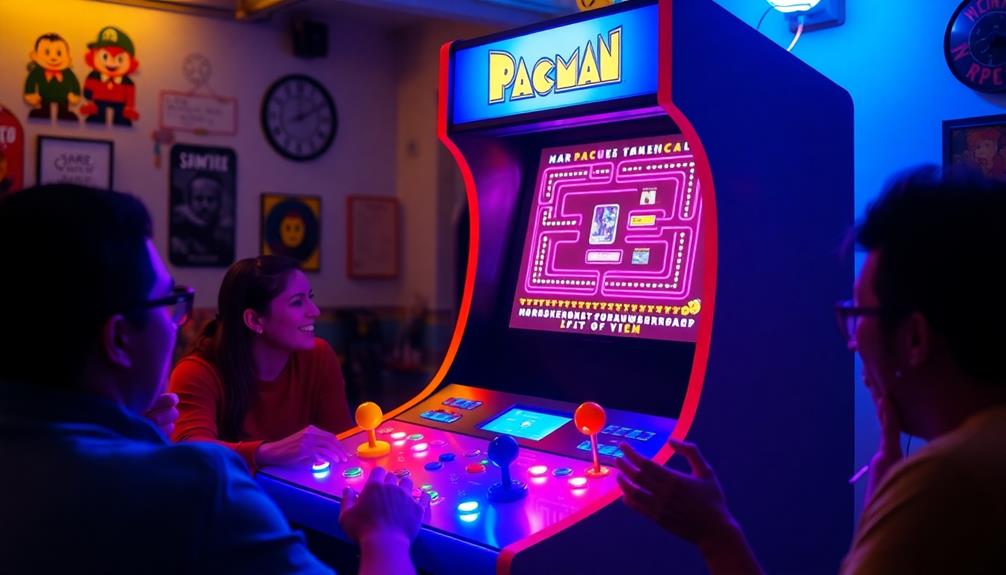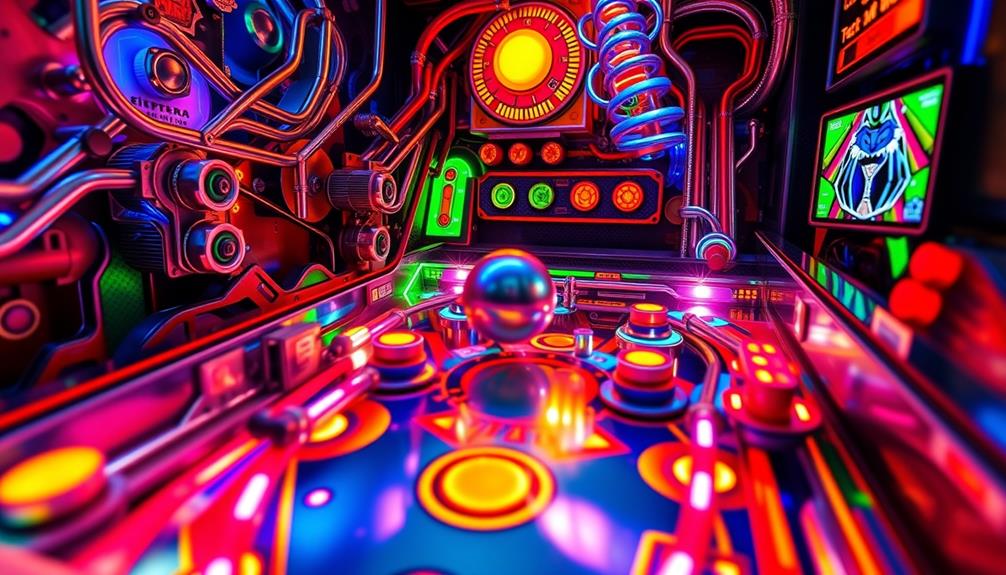The Can Can Pinball Machine, manufactured by Bally in 1961, captures the vibrant culture of its era. It features innovative gameplay mechanics that differentiate it from typical pinball machines. While there is minimal interest among collectors currently, with only a few owners mentioned in community databases, there are various challenges in restoring it due to parts scarcity. Nevertheless, passionate fans are committed to maintaining its legacy. Engaging with the community can provide you with assistance and information if you have an interest in this vintage piece, offering a chance to learn more about its importance. Being one of the rare pinball machines from the 1960s, the Can Can Pinball Machine holds a special place in the hearts of those who value its historical significance. Despite its rarity, dedicated collectors and enthusiasts persevere in their efforts to locate and preserve these exceptional gaming relics. By connecting with these like-minded individuals and resources, you can develop a deeper appreciation for the significance and influence of rare pinball machines such as the Can Can.
Key Takeaways
- The Can Can Pinball Machine, produced by Bally Manufacturing Co. in 1961, embodies the cultural spirit of its era and unique gameplay mechanics.
- It is one of only 867 machines released by Bally, highlighting its rarity and historical significance within the pinball community.
- Restoration challenges include sourcing rare parts, with a community of enthusiasts sharing resources and support for successful projects.
- Current market trends show limited collector interest, with no recent listings or pricing data available, indicating a potential gap in demand.
- The machine's aesthetic design reflects early 1960s trends, making it a valuable artifact for collectors and arcade history enthusiasts.
Overview of the Can Can Machine
The Can-Can pinball machine, produced by Bally Manufacturing Co. in 1961, stands out as a vibrant piece of arcade history. With its lively theme inspired by the exuberant Can-Can dance, this machine captures the artistic and cultural spirit of its time. As one of 867 machines released by Bally Manufacturing since its founding in 1930, it showcases the company's commitment to innovation in the domain of pinball machines. The Can-Can pinball machine is a testament to Bally’s dedication to crafting engaging and visually striking gaming experiences. Renowned for their meticulous design and attention to detail, Bally had already solidified its reputation as a leader in the pinball industry decades before, with its first pinball machine release date tracing back to 1932. This machine not only highlights the technical advancements of its era but also serves as a nostalgic reminder of the golden age of arcade entertainment.
Understanding the importance of diversification strategy can enhance appreciation for how various themes and designs contribute to the richness of arcade gaming experiences.
While the Can-Can reflects a significant era in arcade gaming, it currently lacks assigned ratings or market listings. This absence highlights a potential gap in the community's engagement and interest, leaving it somewhat overlooked among enthusiasts.
Despite having 15,124 members in the Vintage Arcade Preservation Society, you won't find the Can-Can listed in ownership or wish lists, indicating that its unique charm hasn't fully resonated with collectors.
The Can-Can pinball machine represents more than just a game; it's a snapshot of a bygone era. Exploring its design and mechanics can deepen your appreciation for Bally Manufacturing's contributions to arcade gaming and the evolution of pinball machines.
Historical Significance and Features

Bally Manufacturing's Can-Can pinball machine not only reflects the vibrant culture of the early 1960s but also serves as a pivotal piece in the history of arcade gaming. Produced in 1961, this bingo-style machine showcases unique gameplay mechanics that set it apart from traditional pinball machines, appealing to both collectors and vintage arcade enthusiasts.
With 867 machines produced since 1930, Can-Can represents an important part of Bally's legacy. Its charm and allure can be likened to how astrology claims to influence personality traits and attractiveness, as it captures the essence of its era in both design and gameplay.
The design aesthetics of the Can-Can capture the visual and cultural trends of its time, making it a significant artifact for understanding the era's arcade gaming scene. Its limited availability and scarcity in the current market emphasize its rarity and historical importance within the pinball community.
Additionally, the promotional flyer from 1961 serves as an essential marketing artifact, highlighting the design and advertising strategies of that period.
This combination of unique gameplay, cultural representation, and marketing history makes the Can-Can pinball machine a fascinating subject for those interested in the evolution of arcade gaming. It's not just a game; it's a reflection of a specific time in history that continues to resonate with enthusiasts today.
Restoration Journey and Challenges

Restoring a Can-Can pinball machine can be an exhilarating yet intimidating task, as the journey often reveals unexpected challenges. You began this project in December 2013, and within four months, you tackled disassembly, cleaning, and reassembly. Right from startup, you faced a blown fuse and issues with broken leaf blades and missing parts.
To help you visualize the challenges, here's a quick overview:
| Challenge | Solution | Outcome |
|---|---|---|
| Blown fuse | Replaced with new fuses | Machine powered on |
| Broken leaf blades | Sourced replacements | Improved gameplay |
| Missing parts | Scoured online marketplaces | Completed restoration |
The lack of spare parts and tools caused initial setbacks, but your determination led you to source the necessary components and knowledge. You also used auto paints mixed with original colors for touch-ups and created master stencils from Mylar film for precise graphics reproduction. Your previous experience restoring the Jalopy pinball machine greatly boosted your confidence and skills, ultimately contributing to your successful restoration of the Can-Can machine.
Community Engagement and Resources

Over the years, community engagement has proven vital for enthusiasts of the Can-Can pinball machine, as it opens doors to invaluable resources and support.
Despite limited involvement, the potential for growth is significant, especially with online platforms like Pinside. Here, you can connect with fellow restoration enthusiasts who share tips and experiences regarding the Can-Can.
Engaging with experts in areas like AI cybersecurity jobs can also provide insights into protecting your digital resources related to pinball restoration.
Engaging with experts and websites, such as bingo.cdyn.com, is essential for accessing schematics and technical support. This knowledge-sharing fosters a collaborative spirit vital for successful restoration projects.
Acknowledging contributors like Phil Hooper, Dennis Dodel, and Tim highlights the importance of community interaction, where specialized knowledge flows freely.
Market Trends and Value Insights

While the Can-Can pinball machine has a rich history, its current market trends suggest a stagnant interest among collectors. With no recent listings or historical pricing data available on Pinside Market, it's clear that activity surrounding this machine is limited.
Only two Pinsiders own the game, and neither has added it to their wish lists, which indicates low demand. This situation highlights the importance of high-quality content in attracting potential buyers and engaging the pinball community.
Here are some key insights regarding the Can-Can's market value:
- Lack of Ratings: The machine hasn't received any ratings on Pinside, pointing to a disengaged community.
- Limited Ownership: Just two collectors own the Can-Can, further showcasing its niche status.
- Restoration Challenges: The scarcity of spare parts may deter potential buyers looking for easily serviceable machines.
- Potential for Future Listings: Despite current inactivity, increased community interest could lead to future sales.
Frequently Asked Questions
Why Was Pinball Banned in Us?
Pinball was banned in the U.S. because authorities viewed it as a game of chance associated with gambling. Critics argued it led to juvenile delinquency and disrupted public order, prompting cities to impose strict regulations.
How Much Is a Pinball Machine Worth?
When you think about the value of a pinball machine, it's like uncovering a hidden treasure. Factors like rarity and condition play essential roles, so you'll want to do some research before diving in.
Were Pinball Machines Illegal in the 70S?
Yes, pinball machines were illegal in many areas during the 1970s due to gambling concerns. However, rulings in places like California started changing that, allowing their return to arcades and bars across the country.
Why Are Pinball Machines so Expensive?
You'll find pinball machines often carry a hefty price tag due to their charming craftsmanship, limited editions, and nostalgic appeal. Restoration costs can also inflate values, making them prized possessions for collectors and enthusiasts alike.
Conclusion
As you step away from the vibrant lights and melodies of the Can Can pinball machine, you realize it's more than just a game; it's a time capsule, capturing the spirit of an era. Each flip of the flipper echoes stories of joy and camaraderie, reminding you that even in a digital age, there's beauty in nostalgia. Embrace the journey of these machines, for they symbolize not just play, but the connections that bind us across generations.









